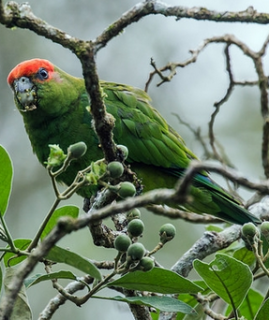Pileated Parrot |
|
|
Also known as: Red-capped Parrot
Photos
View in GalleryDid You Know?
If alarmed the Pileated Parrot will "freeze" momentarily before flying off.Academic Research
Related publications: Pionopsitta pileataSpecies Profile
Genus: Pionopsitta | Species: pileata
Size:
22cm (8.6 in)
Weight:
98-120g (3.4-4.2 oz)
Subspecies including nominate:
one
Colour Adult:
Male-in general green plumage; red forehead, crown, and lores to area around eyes; brown/purple ear coverts; purple/blue outer lesser underwing coverts; blue/green inner lesser underwing coverts; green tail tipped with blue. Bill green/grey, becoming horn in colour towards tip. Eye ring bare and grey. Eye dark brown. Female-green crown and lores to area around eyes; green forehead tinted with blue.
Colour Juvenile:
In male red confined to thin frontal band with orange/yellow patch behind; female as in adult.
Call:
Calls made in flight are rapid and repititious high-pitched shrieks; also a three syllable series of notes. Loud, babbling chatter from perched flock.
Listen NowVideo Links:
Video 1More Information:
Content Sources:
CITES
BirdLife International
Cornell Lab of Ornithology/Birds of the World
ML Media Collection Catalogue 133954, Pileated Parrot Pionopsitta pileata, Andersen, Michael, Misiones, Argentina, Dec. 1 2006, Cornell Lab of Ornithology. Site
Parrots of the World, Forshaw and Cooper, 1977. 2010 edition
Parrots of the World, Forshaw, 2006.
Lexicon of Parrots, Thomas Arndt.
Parrots in Aviculture, Low, 1992.
Photos
View in GalleryDid You Know?
If alarmed the Pileated Parrot will "freeze" momentarily before flying off.Academic Research
Related publications: Pionopsitta pileataSpecies Care
Captive Status:
Uncommon in captivity.
Longevity:
Not recorded.
Housing:
In a secluded location, aviary or suspended enclosure, minimum length 2m (6.5 ft).
Diet:
Fruits such as: apple, orange, pear, banana, pomegranate, cactus fruits, forming about 30 percent of the diet; vegetables such as: carrot, celery, green beans and peas in the pod; fresh corn; boiled maize; green leaves such as: Swiss chard, lettuce, sowthistle, dandelion, chickweed; small seed mix such as: canary, millet, and smaller amounts of oats, buckwheat, safflower and a little hemp; soaked and sprouted sunflower seed; cooked beans and pulses, and complete kibble.
Enrichment:
Likes to run along branches so provide many different sized ones; also ropes and ladders. Mild chewer, so provide bird-safe, unsprayed flowering, fir, willow or pine branches and vegetable tanned leather toys.
Nest Box Size:
Vertical box 10" x 10" x 20" (25.4cm x 25.4cm x 51cm).
Clutch Size:
3-4
Incubation Time:
24-25 days
Fledging Age:
47-54 days
Hatch Weight:
Not recorded.
Peak Weight:
Not recorded.
Weaning Weight:
Not recorded.
Photos
View in GalleryDid You Know?
If alarmed the Pileated Parrot will "freeze" momentarily before flying off.Academic Research
Related publications: Pionopsitta pileataSpecies Wild Status
World Population:
Unknown, but uncommon.
IUCN Red List Status:
Least Concern
CITES Listing:
Appendix I
Threat Summary:
Not globally threatened. Is declining due to widespread loss of forest to urban growth, agriculture and mining. Still persists in reasonable numbers where cover extensive, notably Paraná and adjacent states in Brazil and is still common in the Alto Paraná region, Paraguay. There have been no recent records from Corrientes, Argentina, but still apparently common in Misiones.
Range:
SE Brazil, E Paraguay and NE Argentina.
Habitat:
Found up to 1500m (4920 ft) in forest, including moist tropical forest and Araucaria stands, mainly in lowlands in the south of its range but also in coastal mountains in Brazil.
Wild Diet:
Feeds on fruits of Podocarpus, Livistona chinensis, Philodendron bipinnatifidum, Eremanthus and “cambuí, seeds of Solanum mauricianum, bark of Eucalyptus, and ripening cultivated fruit.
Ecology and Behaviour:
Seen in flocks of 10 or so, not usually more than this. Nests in tree cavity. Are inconspicuous while feeding and resting though sentinels may keep watch from exposed perches.
Clutch and Egg Size:
3-4 rounded eggs, 26.0 x 22.5mm (1 x 0.8 in).
Breeding Season:
Probably November-January. Nest is tree hollow.
Related Links:
Wikipedia
Research: Phylogeny and comparative biogeography of Pionopsitta parrots and Pteroglossus toucans
Photos
View in GalleryDid You Know?
If alarmed the Pileated Parrot will "freeze" momentarily before flying off.Academic Research
Related publications: Pionopsitta pileataMembers Only Resources
Please log-in now to find more research, resources and tools.
Not a Member?
Find more great information:
Gain exclusive access to 600+ pages of additional research, seminars and podcasts, specialists to ask your toughest questions, and dozens of other fun resources - when you become a WPT member.
Join Today >>

































